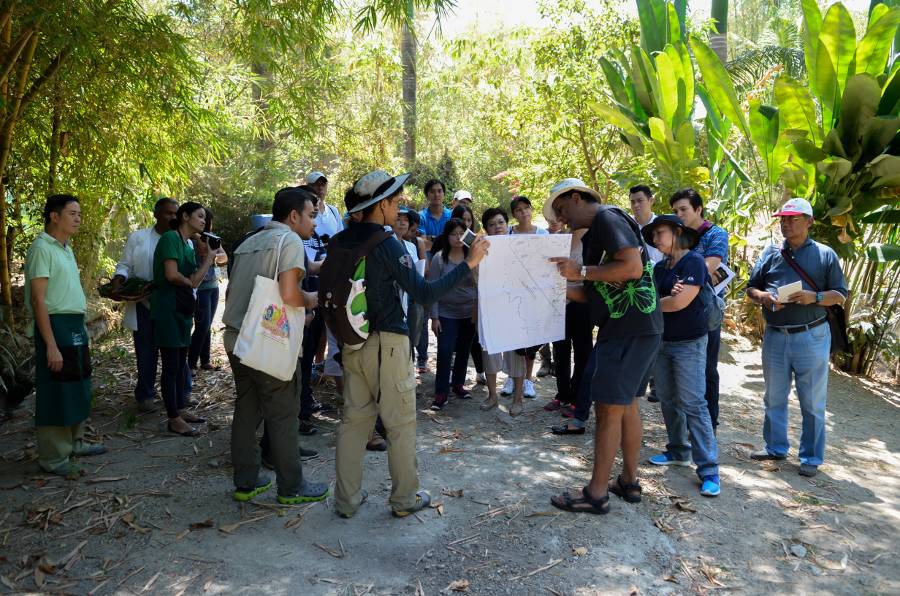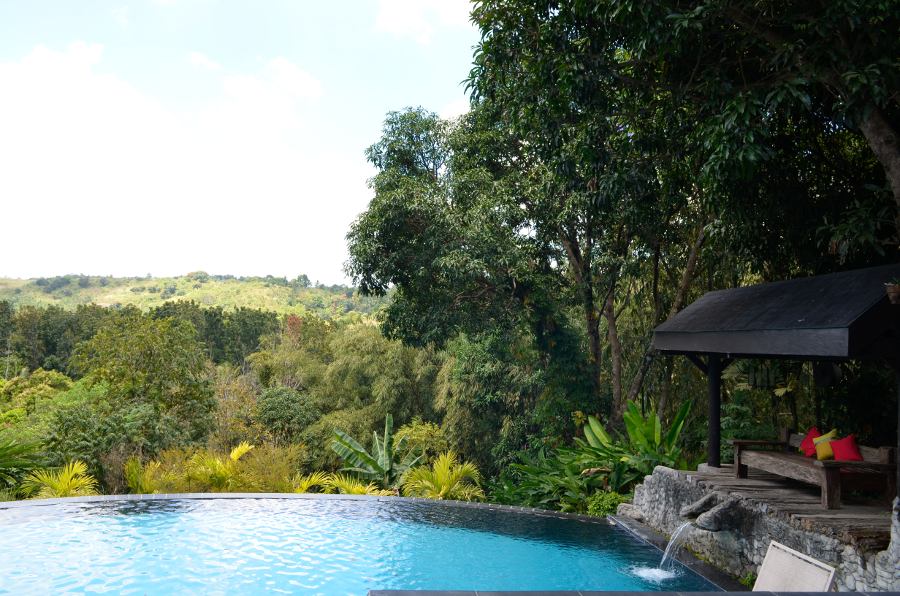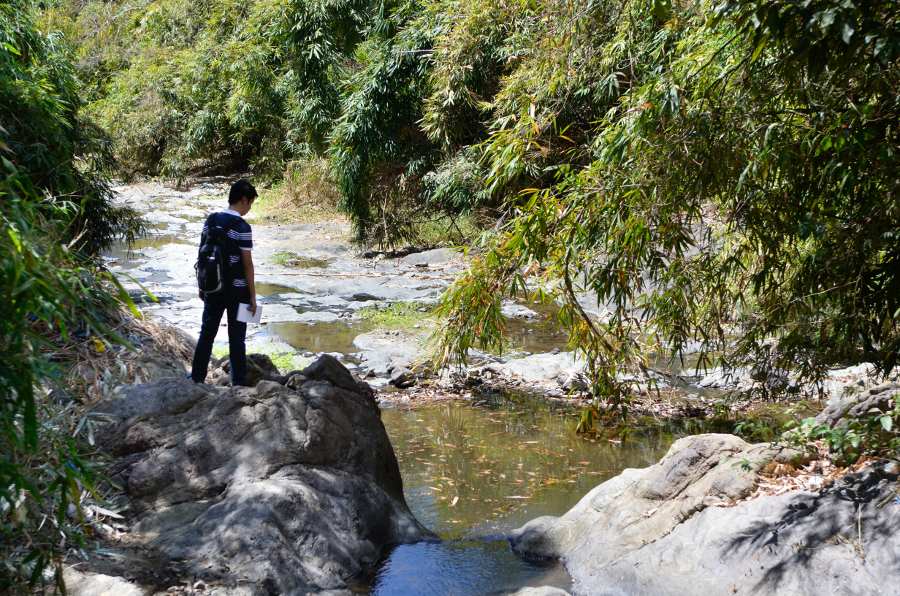
Notes from a metaphysical site analysis
On the third day of the workshop, Hitesh Mehta and Mina Gabor brought the participants to Flor’s Farm and Garden, a private five-hectare property for family outings. With a design charette as culminating activity of the workshop, participants would be asked to redesign Flor’s Garden into an ecolodge or event space using the principles of ecolodge planning and design. To prepare for the charette, participants spent the day there to get acquainted with the site, the owner and her philosophy, and to appreciate what the place has to offer as the knowledgeable staff served up tasty, organic Filipino merienda and meals (including lechon, which they insisted was healthy because the farm’s pigs eat only organically grown food).
As the group toured the grounds, Mehta asked the participants to be sensitive to the site and try to sense whether certain areas had strong or weak, positive or negative energy. “Where do you feel naturally drawn? Where does it feel peaceful?” he asked. “Those are important things to remember when designing.”
A lot was accomplished that day: measuring and establishing boundaries, drawing the base plan, carrying out physical and metaphysical site analyses, and finally, preparing site analysis plans for presentation the next day. Anthony Abrias of the Philippine Native Plant Conservation Society did a quick survey of the plant species in Flor’s Garden, and informed the workshop participants of particular plants in the property that were native and endemic, and therefore to be encouraged; and which ones were exotic and invasive alien species, to be controlled, removed or destroyed.


Experiencing the site
The highlight of the day was the metaphysical site analysis using a six senses approach, an exercise that Mehta does at all the sites he works on, before he draws even a single line.
“My mission is to convert your soul to the natural world out there,” declared Mehta, adding: “My mission is to turn you into holistic designers and developers.” For Mehta, designing and developing holistically goes beyond working at the outset in multidisciplinary teams—although that in itself is vital to the successful planning of ecolodges.
The cornerstone of ecotourism and building ecolodges, says Mehta, is an attitude of respect for all, which is very similar to the ethical principle of ahimsa or non-violence towards other living creatures. And because one cannot protect that which one does not understand, what designers, developers and property owners need to develop, Mehta asserts, is the ability to empathize with living and even non-living things. He quotes Albert Einstein:
“A human being is a part of the whole called by us ‘universe,’ a part limited in time and space. He experiences himself, his thoughts and feeling as something separated from the rest—a kind of optical delusion of his consciousness. This delusion is a kind of prison for us, restricting us to our personal desires and to affection for a few persons nearest to us. Our task must be to free ourselves from this prison by widening our circle of compassion to embrace all living creatures and the whole of nature in its beauty.”

Sense of place
And so the architects, planners, developers and resort owners, including members of BluPrint’s team, each went off on their own metaphysical site analysis—to see, hear, touch, smell, taste and feel the site. We were told to pick a spot, and for about 10-15 minutes, focus only on seeing and looking at our surroundings, blocking out the other senses, and jot down our impressions, uncensored, on a notepad. We were encouraged to notice details that we normally might overlook. The same process would be done for each of the other senses (although understandably, people spent the shortest time on tasting), always writing down our stream of conscious. The most revelatory and transcendent part of the exercise was the feeling part, when people spent time being one with the site. “Be a bird, be a tree, be the ground, an ant or a stone,” Mehta told us. “Feel the environment around you through the perspective of that being. How do you feel? If you want to write a poem or a song, please do so.”

Compassion and empathy
The class was divided into four groups. Although most participants seemed self-conscious or bashful at the start of the exercise, by the end, everyone embraced it wholeheartedly, and appeared to be refreshed and reflective. Perhaps because there were some signs of degradation in certain areas of the property, particularly the creek, which we were told has been drying up through the years, the six senses impressions that the groups shared the following day were a mix of happy, serene, nostalgic and melancholic. Here are excerpts:
Sight: Creation, decay and struggle
• Railroad ties showing botches of deterioration and scars from utility
• Split bamboo slats with stains from iron nails
• Banana plant in various stages of decay
• Ficus crawling up a tree, its roots grappling for a hold
• Water spiders skimming the surface
• Tiny guppies swimming upstream but getting nowhere
• Small twig helplessly carried away on the gentle current
• Clay colloids serve as path covers for termites
• Play of light and shadows as tree branches shift and clouds pass
• ‘Blackness’ from the overwhelming sound of blood rushing when ears are covered
• Textured striations carved out on the rock by the water
• White wisps of clouds like fine hairs on a child’s cheek
Sound: Nature, man and machine
• Gravel crunching under the wheels of a passing car
• Thrumming motorcycle engine that seems to go on forever
• Dog barking
• Birds call out, screeching
• A strange meowing
• Water is tranquil as it trickles down the stream
• Bubbles go plop, plop, plop like small bamboo chimes but softer, rolling as they sink into themselves
• An old man singing old ballads triggers a memory of old songs yaya used to sing
• Memories of Sunday morning when freshly baked pan de sal is delivered to the house
• Bamboo striking each other—a symphony, a gentle drumbeat of mother’s fingers playing across her pregnant belly
• Leaves rustling triggers memories of weekend lunches and oil sizzling, fried maya-maya with steaming white rice
• Rooster crows in the distance
• Shisshing leaves as a snake slithers away
• The sound of infiniteness
Smell: Birth and death
• Leaves smell fresh, of life and summer
• The air smells transparent, like pristine light
• Fallen leaves smell like life and water
• Burning coal brings pleasant memories
• Earth smells of rust
• Muddy water smells like blood
• Rock smells like a thousand years
• Petrol smell near cistern
• Dust by the roadside
• Sun baking the earth
• Manure, unseen organisms toiling
Touch: Contrasts
• Cold, silky moss on a rough branch
• Grittiness of silt, smoothness of water flowing
• Hard earth, soft young leaves
• Hot and cold rocks
• Cool and clean water coursing through fingers feels like silk
• Rock is ice cold crawling up the back
• Dimples, pimples and grooves
• Sharp thorns
• Hairy plants, waxy leaves
• Rough riprap
• Dried leaves feel old and tired
• Wet leaves feel like wet clothes
• A giant red ant walking like needles on the skin
Taste
• Air tastes clean
• Leaves are minty and wansuy-like
• Water is cool and soothing under the sun
• Brown water, metallic and menacing?
• Bitter but fresh tasting leaves
• Sweet leaves of tomato
Feeling
One of the participants, architect Charm Cabredo, chose to be one of the boulders in the middle of the creek. She lay down on it, face to the sky, unmoving for several minutes. Her poem:
Groan.
Liquid light shivers;
The first dusts of summer slowly settle into the busy river bed.
A rumble, a thrill, glorious sun.
The night’s cold is fervently offered to the sky.
Welcome sun! Welcome light!
White winged pairs frolic over this gray body, ignoring the heavy sigh as leaves fall quietly,
tentative.
Listen. The river whispers secrets from the neighbour upstream,
and carves out lovers’ promises against my side
where granite meets the knife-cold water.
Witness. To be one is inevitable.
She moves gracefully through time carrying away these memories,
Light-filled fingers tracing secrets playfully.
Until then, I wait patiently until the clouds bring her back and her laughter washes over me.

Higher Consciousness
“And we were just in Antipolo—imagine if we did this in a pristine site!” one of the participants told BluPrint. Skeptics may scoff, but it stands to reason that owners, developers, designers and planners will tread more lightly on the land when they feel a kinship with the land and the creatures in it, which is why metaphysical site analysis, in addition to rigorous physical site analysis, is very effective in helping ensure that the ecolodge and the experiences one designs for it will be in harmony with the site.
The designer’s challenge is to create this harmony despite the conflicting interests of tourism development and environmental protection. In his book, International Ecolodge Guidelines, Mehta sets an even higher standard. “A fundamental goal for any ‘eco’ project,” he says, “is that the development of the site must leave the site better off after development than before.”
After all the teams had presented their physical and metaphysical site analyses, Mehta raised the bar yet again, quoting from Christopher Alexander’s book, The Luminous Ground, and challenging participants to “make the practice of architecture nothing less than a path to higher consciousness, a path to God.” With that appeal, Mehta charged the teams to work on their site plans and perspectives for presentation to a jury on the last day of the workshop. ![]()
Metaphysical Site Analysis and Design
Source: Hitesh Mehta, International Ecolodge Guidelines
The majority of site analysis and planning techniques being practiced today are objective and one-dimensional. A new way of thinking is needed in order to create ecolodges in total harmony with the existing landscape, which after all, is the compelling reason for the existence of the lodge. What we need is a subjective and holistic approach so that the plans and designs we create provide a sense of place and feeling of sacredness, and provide the ecotourist with a spiritual communion with nature—qualities that are all too missing in traditional tourism lodges.
In the context of the ecosystem theory, holism is based on the concept that living and non-living components function together as a whole to well-defines biological laws. Everything is connected: humans, plants, animals and non-living objects.
The six senses approach is just one of many holistic philosophies being practiced around the world that provide all-inclusive approaches to design. Other examples are feng shui from China, Vaastu Shastra from India, the traditions of American Indians of North and South America, and the aborigines of Australia.
This article first appeared in BluPrint Vol 3 2015. Edits were made for Bluprint.ph.


